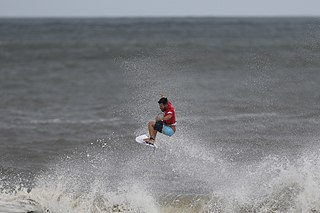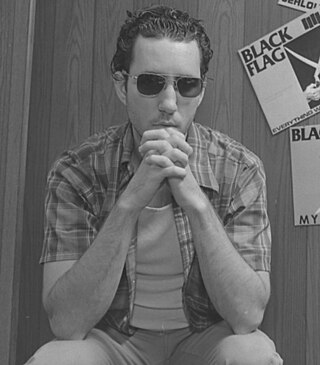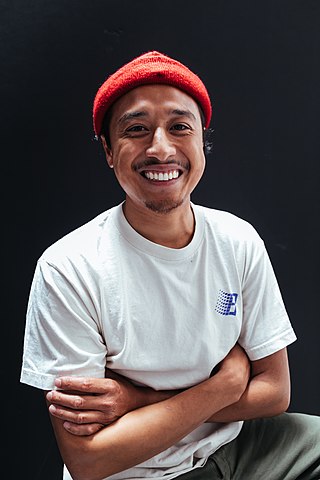
Surfing is a surface water sport in which an individual, a surfer, uses a board to ride on the forward section, or face, of a moving wave of water, which usually carries the surfer towards the shore. Waves suitable for surfing are primarily found on ocean shores, but can also be found as standing waves in the open ocean, in lakes, in rivers in the form of a tidal bore, or in wave pools.

Raymond Pettibon is an American artist who lives and works in New York City. Pettibon came to prominence in the early 1980s in the southern California punk rock scene, creating posters and album art mainly for groups on SST Records, owned and operated by his older brother, Greg Ginn. He has subsequently become widely recognized in the fine art world for using American iconography variously pulled from literature, art history, philosophy, and religion to politics, sport, and sexuality.

Surf culture includes the people, language, fashion, and lifestyle surrounding the sport of surfing. The history of surfing began with the ancient Polynesians. That initial culture directly influenced modern surfing, which began to flourish and evolve in the early 20th century, with its popularity peaking during the 1950s and 1960s. It has affected music, fashion, literature, film, art, and youth jargon in popular culture. The number of surfers throughout the world continues to increase as the culture spreads.

Montañita is a small coastal town in Ecuador located in the parish of Manglaralto, province of Santa Elena, about 180 kilometers northwest of Guayaquil. Its name means "small mountain." In the mid 20th century it was known as a surfing beach, with only a few fishermen's huts, and one or two surfers tents in summer, erected at the site. But in 1960, Montañita, foreigners linked to the hippie movement decided to settle there permanently. It is now a popular destination for surfers from around the world and considered one of the best surfing beaches in Ecuador's south coast.

Peʻahi is a place on the north shore of the island of Maui in the U.S. state of Hawaii. It has lent its name to a big wave surfing break, also known as Jaws.

The riding of waves has likely existed since humans began swimming in the ocean. In this sense, bodysurfing is the oldest type of wave-catching. Undoubtedly ancient sailors learned how to ride wave energy on many styles of early boats. Archaeological evidence even suggests that ancient cultures of Peru surfed on reed watercraft for fishing and recreation up to five thousand years ago. However, standing up on what is now called a surfboard is a relatively recent innovation developed by the Polynesians. The influences for modern surfing can be directly traced to the surfers of pre-contact Hawaii.

A surf break is a permanent obstruction such as a coral reef, rock, shoal, or headland that causes a wave to break, forming a barreling wave or other wave that can be surfed, before it eventually collapses. The topography of the seabed determines the shape of the wave and type of break. Since shoals can change size and location, affecting the break, it takes commitment and skill to find good breaks. Some surf breaks are quite dangerous, since the surfer can collide with a reef or rocks below the water.
The Surfer's Journal is a publication based out of San Clemente, California. Founded in 1992 by Steve and Debbee Pezman, the reader-supported magazine comes out six times a year. It is edited by Alex Wilson and published by Debbee Pezman.

This glossary of surfing includes some of the extensive vocabulary used to describe various aspects of the sport of surfing as described in literature on the subject.[a][b] In some cases terms have spread to a wider cultural use. These terms were originally coined by people who were directly involved in the sport of surfing.

The North Shore, in the context of geography of the Island of Oʻahu, refers to the north-facing coastal area of Oʻahu between Kaʻena Point and Kahuku. The largest settlement is Haleʻiwa.

The beaches in Póvoa de Varzim are an extensive and continuous group of golden sandy beaches forming small bays or coves along the shoreline in northern Portugal. These do not have any barrier and are in fact a single beach, over 12 km long, under the name Praia da Póvoa de Varzim. Division may be arbitrary and serve localization porpoises.

Ecuador has many beaches for surfing: the coast of Ecuador is 2,237 km long. Surfable waves are available in Ecuador year-round, and surfers enjoy the mild year-round weather, especially in the northern region where the weather conditions attract many surfers from all over the world. Within this part of South America, Ecuador's neighbors Chile and Peru also offer great surfing. Many surfers in Ecuador use a protective wetsuit. Surf tourism is very important to the local economy, and the beaches offer significant enjoyment because of top quality waves combined with affordable prices for lodging and food compared to other surf destinations. There's also a national marine reserve off the coast, which has a gigantic whale population.

Sidi Kaouki is a small town located 25 km south of Essaouira. It is a rural commune in Essaouira Province of the Marrakech-Tensift-Al Haouz region of Morocco. At the time of the 2004 census, the commune had a total population of 4335 people living in 902 households.

The Reincarnation of a Surfboard is a body of sculpture work created by Ithaka Darin Pappas. The project, which began in 1989 consist of approximately 300 wall-mounted sculptures that have been made using recycled surfboards as raw building material. The series to date has been exhibited on four continents. The most recent solo exhibitions of these works were mesa hosted by WOA - Way Of Arts in Cascais, Portugal in December 2012, by Hurley International in Costa Mesa, California in October 2013 and F+ Gallery in Santa Ana in February 2015.

Tourmaline Surfing Park is a beach access point and surfing spot in North Pacific Beach, a community of San Diego, California. The park is situated at the northern end of Pacific Beach, a short distance south of where the sand beach ends and the rocky promontory of La Jolla begins. There are cliffs to the north and south of Tourmaline Surfing Park, but the park itself lies in Tourmaline Canyon, which cuts down through the cliffs to the beach. Tourmaline Surfing Park is also known locally as Old Man's and is a known for its more gentle waves. It attracts surfers of all kinds but is known as a great spot for longboarders and beginners.
Anthony Friedkin is an American photographer whose works have chronicled California's landscapes, cities and people. His topics include phenomena such as surf culture, prisons, cinema, and gay culture. Friedkin’s photographs have been exhibited in the Los Angeles County Museum of Art and the J. Paul Getty Museum. His photographs are included in major Museum collections: New York's Museum of Modern Art, The J. Paul Getty Museum and others. He is represented in numerous private collections as well. His pictures have been published in Japan, Russia, Europe, and many Fine Art magazines in America.

Surfing in the United States is a popular hobby in coastal areas, and more recently due to the invention of wave pools, inland regions of the country. It contributes to a lifestyle and culture in which millions participate and which millions more have an interest. USA surfing is the governing body for the sport of surfing in the United States, with surf leagues such as the World Surf League available in the country. Surfing can be traced back to 17th Century Hawaii and has evolved over time into the professional sport it is today, with surfing being included for the first time in the 2020 Summer Olympics in Tokyo.
John Severson was an American editor, author, filmmaker and artist, widely known as the founder of Surfer, a magazine focused on the sport and culture of surfing. Severson also created a diverse body of artwork dedicated to the sport.

AJ Dungo is an American surfer and illustrator known for his 2019 graphic novel In Waves. While writing In Waves, Dungo was a CMF designer for a footwear manufacturer. The book was originally an art school project about surfer Tom Blake, but expanded to include information on Duke Kahanamoku in what Surfer magazine calls "the creeping face of the commercialization of Hawaiian surf culture." While working on this project, Dungo's partner of eight years died from cancer and Dungo weaves his own grief into this surfing history book.

Ithaka Darin Pappas, known professionally as Ithaka, is an American-born multidisciplinary artist of Greek ancestry who creates using music, writing, sculpture and photography. He has authored a collection of short stories, entitled Ravenshark Chronicles published in international magazines and periodicals, which have sometimes been the basis for his travel-oriented lyrical content. In a 2005 article for the magazine Waves, journalist Ricardo Macario described Ithaka as "The Miscellaneous Man". In a 2008 review of Ithaka's sixth album Saltwater Nomad, the online surf-culture platform Surfline stated that "the artist effortlessly traverses at ease between all of his choses mediums of expression [music, sculpture, writing and photography]", and that "his life's journey is a soulful balancing act somewhere between the worlds of euphoric creation and aquatic diversion."

















